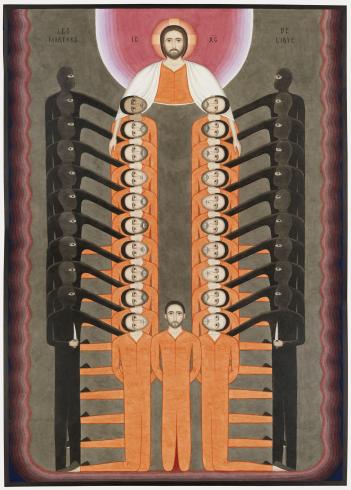Nikola Sarić, born in Serbia in 1985, lives and works in Hanover (Germany). He discovered Byzantine art during his studies at Belgrade University’s Academy of Applied Arts. Impressed in particular by the beauty of the Medieval frescos at Studenica Monastery, he specialised in learning the techniques of fresco, icons and drawing at the Academy of the Serbian Orthodox Church for Arts and Conservation, while furthering his knowledge of early Christian art in its Armenian, Coptic and Byzantine expressions. Aware of the impoverished state of contemporary iconic art, he chose to believe in the potential for creativity and renewal in this field.
His artistic research led to a vision nourished by graphic, stylised elements. Further stylistic sources taken onboard were drawn from Eastern Antiquity, Art Nouveau, 1930s art, and comic books, culminating in an original body of work concerned with recomposing and simplifying existing patterns. The use of techniques and chromatic ranges not found in Byzantine art, notably in his pastel-toned watercolour paintings, has contributed to the renewal of iconic art. The artist’s graphic, streamlined style lends his figures a magnetic presence served by an often enigmatic atmosphere, which is not contradicted by the overall softness.
Composed based on the execution video posted on social media, The Martyrs of Libya synthesises the various elements of the macabre staging carefully orchestrated by ISIS: the twenty-one hostages are lined up on their knees, wearing the orange jumpsuits given to them in reference to the prisoners of Guantanamo Bay. The executioners form another line behind them. Concealed behind the black hooded costumes of the ISIS army, they hold the condemned men on the ground, knife in hand. The borders are stained with the colour of the hostages’ blood, and reach to the sky, where we see the figure of Christ appearing in a cloud. Christ is dressed in the same orange colour as the martyrs, whom he gathers in his arms. The presence of Christ relates to a theological interpretation of the execution, no longer seen simply as a crime, but as a martyrdom.
The image draws on icons of martyrs from the Byzantine tradition, of which the Petit Palais holds several first-rate examples, such as the icon of the Forty Martyrs of Sebaste (Bulgaria, late 17th century), another group martyrdom in the presence of Christ. Reflecting on very recent happenings, the artist aligns his work from the outset with the tradition of hagiographic iconography. This acquisition brings to the museum’s collection the perspective of a young artist focussing on recent historical events, thereby documenting the birth of a cult of contemporary saints, now included in the calendar or the Coptic Church.
R. Z.

City of Paris municipal collection's website
The collections portal can be used to search the collections of Paris’s 14 municipal museums (approximately 336,000 works, including 43,000 belonging to the Petit Palais).
It is also possible to download around 12,000 images of the museum’s works free of charge.
Access the Museums of the City of Paris collections portal
Extern databases
Discover a selection of databases online presenting works from the Petit Palais or documents concerning the history of the museum.

